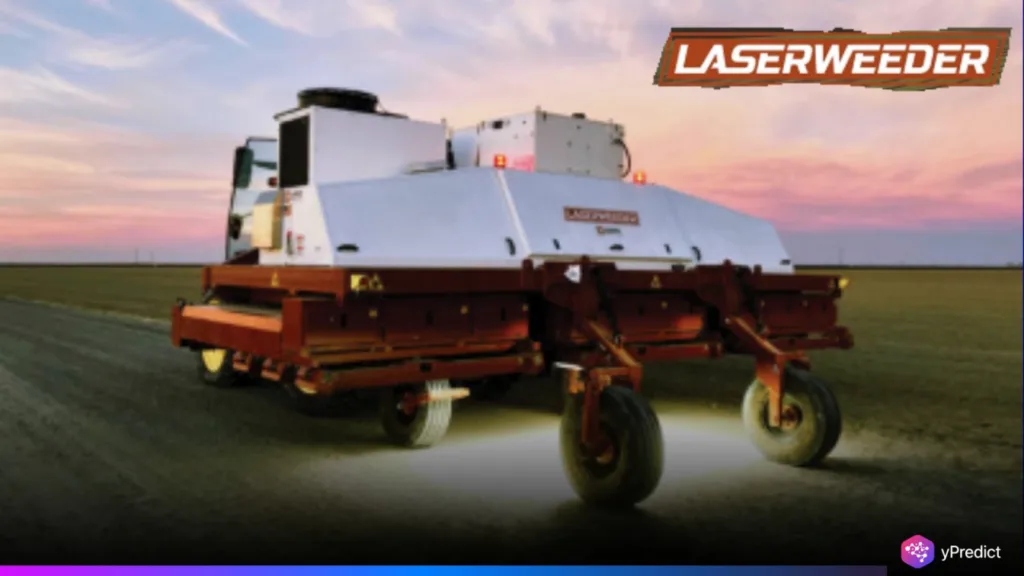
The introduction of the Hg LaserWeeder in Wuhan, China, is a great breakthrough in the agricultural sector. This AI-based robot was designed to work 24/7 with more than 95 percent efficiency in weeding operations that dramatically reduce the use of chemical herbicides. The reason it works is because of computer vision; this allows sub-millimeter precision in distinguishing crops and weeds and removes the latter with a laser. This is not solely an automation shift but a sustainability, safety, and long-term food security shift. The general tendency towards AI-powered farming extends to the Hg LaserWeeder, combining the approach’s efficiency with environmental care.
How AI is Replacing Pesticides, Not Just Labor
This Hg LaserWeeder works with superior precision courtesy of a sophisticated AI vision system. It is trained by huge image datasets, which enable it to recognize weeds and destroy them and leave crops alone; this is a process that traditionally required the broad application of pesticides. During the lost season at the Yunnan tobacco fields, the robot demonstrated a 92 percent efficiency in weeding. This is not just an impressive performance but a much-needed one in countering the problem of pesticide overuse that leads to soil degradation, decreases biodiversity, and poses health threats via tainted food.
In addition to the ecological gains, the labor advantages are great since the robot may work for a long time. The Hg LaserWeeder is able to handle the workload of 30 manual laborers within only one 24-hour cycle. This is not only cost-effective, but it will also be able to provide consistency in the control of weeds that directly affect the health and production of crops.
The possibility of producing agriculture without pesticides is one of the greatest innovations in the food production of the world. As we are getting increasingly paranoid about chemical residues in the vegetables and grains we consume, solutions that turn to AI and make farming safer and cleaner have begun to emerge. The technology is also scalable: farmers could use it both in rice paddies and for high-value cash crops, which attracted people in different parts of the agricultural industry. We can view this interest in the global 2026 pre-order campaign, in which countries seek more environmentally friendly and technology-enhanced agricultural solutions.
Scaling Sustainability- AI’s Global Footprint in Agriculture
Hg LaserWeeder is not appearing in a vacuum. It is in the wake of a rapidly increasing worldwide phenomenon in precision agriculture, of which companies such as Carbon Robotics in the United States are also developing AI-controlled laser weeding systems. It is indicative of a new AI era: it is no longer a lab toy but a field-ready means of changing food systems. The reason why this transformation is urgent is an answer to the triple threat in the making of the agricultural sector: climate volatility, labor shortage, and environmental deterioration. All three are directly tackled by the use of technologies such as the Hg LaserWeeder.
But still, difficulties exist. The costs of adoption may be slow because of high initial investments in small and medium farms, particularly in developing nations. The systems also require constant updates of the software and correct data to detect changing species of weeds, and this results in the question of availability and reliability over time. The momentum is, however, undeniable. As pilot programs grow and financing supports agritech, companies are marketing AI as one of the pillars of 21st-century farming. These advancements go beyond instruments; they become promoters of a new agricultural economy that focuses on sustainability, resilience, and metrics-driven productivity.
The Future of Farming is Intelligent and Laser-Precise
The Hg LaserWeeder is not just a technological innovation; it is an indicator of a wiser, greener, and more agricultural future. Operating on the basis of AI and addressing one of the oldest issues in farming, this robot provides a solution with the help of the most modern technology to minimize the use of pesticides and increase the yields, and make sustainability scalable. The pressures are forcing global food systems to their limit, but a solution to this may become critical infrastructure. The future of agriculture will not only focus on farming more but will also focus on farming smarter. Even AI-driven robots, such as Hg LaserWeeder, are already on the way to that new intelligent and accurate, and sustainable era.






